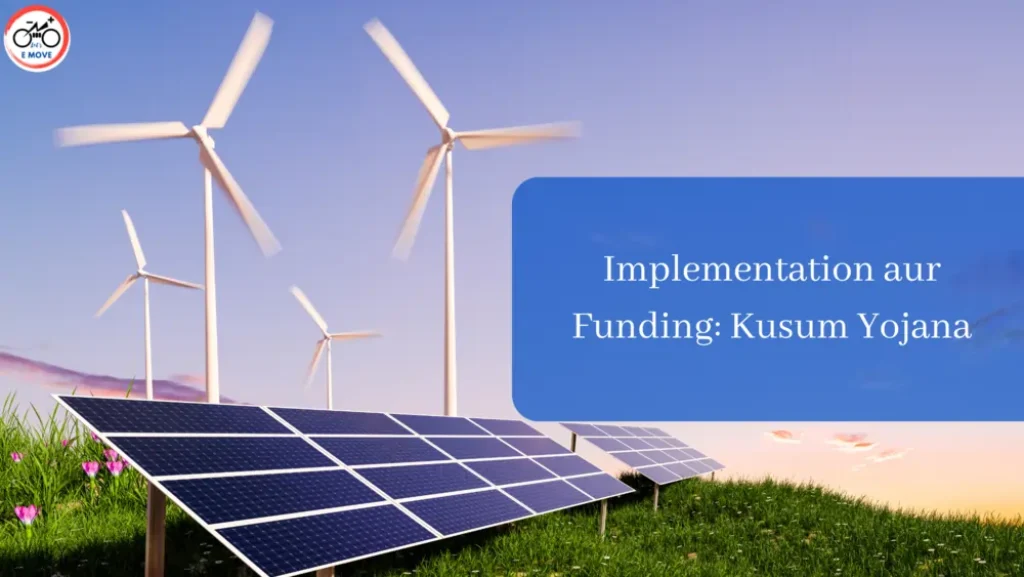
India, ek rapidly developing nation, energy demands ko pura karne aur saath hi environmental concerns ko address karne ki double challenge ka saamna kar raha hai. Sustainable development ke importance ko samajhte hue, Indian sarkaar ne ek innovative scheme launch kiya hai, jiska naam hai Kusum Yojana. Yeh scheme rural areas aur agricultural sector me renewable energy sources, khaaskar solar power ko promote karne ke liye banaya gaya hai.
Table of Contents
Kusum Yojana, jiska full form hai “Pradhan Mantri Kisan Urja Suraksha evam Utthaan Mahabhiyan,” ek comprehensive program hai jo solar power plants ki installation, existing grid-connected agricultural pumps ki solarization, aur barren aur fallow lands par renewable energy generation ko promote karne ke liye design kiya gaya hai. Desh me available abundant solar energy resources ka faayda uthate hue, yeh scheme rural communities ke liye ek zyaada sustainable aur self-sufficient energy ecosystem banane ka target rakhta hai.
Kusum Yojana ke objectives bahut saare hain, jisme ye shaamil hain:
- Renewable energy generation ko badhana aur energy security ko promote karna
- Farmers aur rural communities ke liye financial support aur incentives provide karna
- Carbon footprint ko kam karna aur climate change ke effects ko mitigate karna
- Renewable energy sector me employment opportunities create karna
- Barren aur fallow lands ka efficient use promote karna
Rural areas me renewable energy ko promote karne ki significance ko nahin nakaara ja sakta hai. Rural India, jo traditional energy sources jaise biomass aur kerosene par heavily rely karta hai, aksar clean aur reliable energy tak access karne me challenges ka saamna karta hai. Solar power ke adoption ko encourage kar ke, Kusum Yojana na sirf in energy needs ko address karta hai, balki sustainable development aur environmental conservation me bhi yogdaan deta hai.
Also Read – Solar PV Generation Guidelines
Scheme Components
Kusum Yojana ek comprehensive scheme hai jo teen distinct components par aadharit hai, jinme se har ek rural areas aur agricultural sector me renewable energy promotion ke specific aspects ko address karne ke liye design kiya gaya hai.
Component A: Decentralized Ground Mounted Grid Connected Renewable Power Plants

Yeh component individual farmers, farmer cooperatives, panchayats, ya developers ko 2 MW tak ki capacity ke decentralized ground-mounted grid-connected renewable power plants install karne ke liye encourage karta hai. In power plants se generate hui power ko Distribution Companies (DISCOMs) ko pre-fixed tariff par becha ja sakta hai.
Component B: Installation of Grid-Connected Renewable Power Plants on Barren/Fallow Land

Is component ke tehat, farmers, farmer cooperatives, ya panchayats ke malik barren ya fallow lands par 500 kW tak ki capacity ke renewable power plants install kiye ja sakte hain. In power plants se generate hui power ko DISCOMs ko becha ja sakta hai, aur land owners ko apni land provide karne ke badle lease rent milegi.
Component C: Solarization of Grid-connected Agricultural Pumps

Yeh component existing grid-connected agricultural pumps par solar photovoltaic (PV) panels install kar ke unki solarization par focus karta hai. Is component se farmers apne electricity bills kam kar sakte hain aur surplus power ko DISCOMs ko bech kar additional income bhi kama sakte hain.
Eligibility Criteria
Kusum Yojana ka design individual farmers, farmer cooperatives, panchayats, aur developers jaise bahut saare stakeholders ko benefit provide karne ke liye kiya gaya hai. Lekin, scheme me hissa lene ke liye kuchh eligibility criteria ko pura karna zaroori hai.
Component A aur B ke liye, ye entities eligible hain:
- Individual farmers
- Farmer cooperatives
- Panchayats
- Developers (private ya public entities)
Component C ke liye, grid-connected agricultural pumps wale individual farmers eligible hain.
Iske alawa, applicants ko kuchh aur requirements bhi pura karna hoga, jaise land ownership ya leasing rights, grid connectivity, aur Ministry of New and Renewable Energy (MNRE) ke technical specifications aur guidelines ka compliance.
Implementation aur Funding
Kusum Yojana ek collaborative effort hai jisme central government aur state governments dono ki crucial bhumika hai, implementation aur funding ke mamle me.

Central government, MNRE ke through, scheme ke tehat renewable energy systems ki installation ke liye central financial assistance (CFA) provide karta hai. CFA component aur beneficiary ki category ke hisaab se badalti rehti hai.
State governments scheme ke implementation ke liye potential areas identify aur prioritize karne, land acquisition ya leasing ki suvidha provide karne, aur grid connectivity suni shchit karne ka kaam karti hain. Woh scheme ko promote karne, awareness create karne, aur beneficiaries ko application process me sahayata provide karne me bhi bhumika nibhati hain.
Kusum Yojana ke successful implementation ke liye, public-private partnerships ko encourage kiya jata hai. Private developers aur renewable energy companies scheme me hissa le kar farmers, cooperatives, aur panchayats ke saath collaborate kar ke renewable power plants set up kar sakte hain.
Benefits of Kusum Yojana
Kusum Yojana ke bahut saare benefits hain, jo farmers, rural communities, aur poore desh ko milte hain.

Renewable Energy Generation: Solar power plants ki installation aur agricultural pumps ki solarization ko promote kar ke, Kusum Yojana clean aur renewable energy generation me yogdaan deta hai. Isse na sirf fossil fuels par dependence kam hoti hai, balki climate change ke effects ko mitigate karne me bhi help milti hai.
Income Generation for Farmers: Is scheme ke tehat, farmers apne solar installations se generate hui surplus power ko DISCOMs ko bech kar additional income kama sakte hain. Iske alawa, farmers apni barren ya fallow lands renewable power plants install karne ke liye provide kar ke lease rent bhi kama sakte hain.
Environmental Benefits: Renewable energy sources jaise solar power ke use se greenhouse gas emissions kam hoti hain aur cleaner environment me yogdaan milta hai. Kusum Yojana sustainable development aur ecological conservation ke liye desh ke efforts ko support karta hai.
Energy Security aur Sustainability: Decentralized renewable energy generation ko promote kar ke, Kusum Yojana energy security ko badhata hai aur conventional energy sources par dependence kam karata hai. Isse rural areas ko zyaada reliable aur sustainable energy supply mil sakti hai.
Success Stories aur Case Studies
Kusum Yojana ke already bahut saari success stories aur positive impacts desh ke kuchh hissons me dikhai de chuke hain. Aao scheme ke practical implementation aur benefits ko samajhne ke liye kuchh case studies ko explore karte hain.

Rajasthan: Rajasthan jaise desert state me, jahan solar irradiation levels zyaada hain, Kusum Yojana ko bahut enthusiasm se adopt kiya gaya hai. Component C ke tehat, hazaaron agricultural pumps ki solarization ki gayi hai, jisse farmers apne electricity bills kam kar sakte hain aur surplus power generation se additional income bhi kama sakte hain.
Maharashtra: Maharashtra state me, Component B ko bahut traction mila hai, jahan barren aur fallow lands par kai renewable power plants install kiye gaye hain. Isse na sirf clean energy generate hoti hai, balki land owners ko lease rent payments ke through stable income source bhi milta hai.
Uttar Pradesh: Uttar Pradesh state me, Component A ke successful implementation ke examples dikhai diye hain, jahan farmer cooperatives aur panchayats ne kai decentralized ground-mounted renewable power plants set up kiye hain. In projects se na sirf renewable energy generation me yogdaan mila hai, balki rural areas me employment opportunities bhi create hui hain.
Jahan Kusum Yojana ki implementation se positive changes aaye hain, wahan kai challenges bhi aaye hain, jaise land acquisition issues, grid integration complexities, aur stakeholders ke beech awareness aur capacity building ki kami. Lekin, collaborative efforts aur continuous improvement se, in challenges ko address kiya ja raha hai, taaki scheme ki long-term success suni shchit ki ja sake.
Application Process
Agar aap Kusum Yojana me hissa lena chahte hain, toh application process aur requirements ko samajhna zaroori hai. Application process component aur applicant ki category ke hisaab se badalti rehti hai.
Components A aur B ke liye:
- Suitable land identify karo: Applicants ko renewable power plant install karne ke liye suitable land identify karni hogi, chahe woh unki apni land ho ya leased land.
- Project proposal taiyaar karo: Ek detailed project proposal, jisme technical specifications, project cost, aur financial viability shaamil ho, taiyaar karna hoga.
- Application submit karo: Required documents ke saath application ko designated nodal agency ya state renewable energy development agency ko submit karna hoga.
Component C ke liye:
- Eligible agricultural pump identify karo: Farmers ko apna grid-connected agricultural pump identify karna hoga jo solarization ke liye eligible hai.
- Application submit karo: Required documents jaise land ownership proof aur pump details ke saath, application ko designated nodal agency ya distribution company ko submit karna hoga.
Application process ya toh online ya offline modes se complete kiya ja sakta hai, state guidelines ke hisaab se. Application guidelines, eligibility criteria, aur required documents ko dhyaan se review karna zaroori hai, taaki application process smooth rahe.
Also Read – Subsidy Schemes under MNRE
Frequently Asked Questions (FAQs)
Q: Kusum Yojana ka main objective kya hai?
Q: Kaun Kusum Yojana me hissa le sakta hai?
Q: Kusum Yojana ke kya different components hain?
Q: Kusum Yojana ke tehat projects ka funding kaise hota hai?
Q: Kya farmers Kusum Yojana se income kama sakte hain?
Q: Kusum Yojana ke kya environmental benefits hain?
Future Prospects aur Expansion Plans
Kusum Yojana ki implementation ke baad se hi, isse bahut saara attention aur success mila hai, lekin sustainable energy future ki journey abhi shuru hi hui hai. Sarkaar aur stakeholders scheme ke reach aur impact ko badhane ke tarike dhundh rahe hain.
Ek key prospect future ke liye hai ki Kusum Yojana ko dusre renewable energy initiatives aur programs ke saath integrate kiya jaaye. National Solar Mission aur Jawaharlal Nehru National Solar Mission jaise initiatives ke saath align ho kar, scheme renewable energy development ke liye rural areas me ek comprehensive ecosystem bana sakti hai.
Iske alawa, renewable power plant installations ki target capacity badhane aur scheme ko zyaada states aur regions me laagoo karne ke plans bhi hain. Isse na sirf desh ke renewable energy goals haasil karne me madad milegi, balki rural communities ko scheme me hissa lene aur iske benefits lene ke zyaada mauke bhi milenge.
Sarkaar innovative financing mechanisms aur public-private partnerships bhi explore kar rahi hai, taaki Kusum Yojana me zyaada investments aa sake aur long-term sustainability suni shchit ho sake. Isme national aur international financial institutions, aur private sector entities ke saath collaborations shaamil hain, taaki resources aur expertise ko mobilize kiya ja sake.
Iske alawa, stakeholders jaise farmers, cooperatives, aur panchayats ke liye capacity building aur awareness programs ko badhane ke efforts bhi chal rahe hain. Isse scheme ke effective implementation, solar installations ki proper maintenance, aur scheme ke benefits ko maximize karne me madad milegi.
Continuously evolve aur changing energy landscape ke saath adapt ho kar, Kusum Yojana India ke sustainable aur self-sufficient energy future ki raah par ek flagship initiative ban sakta hai.







